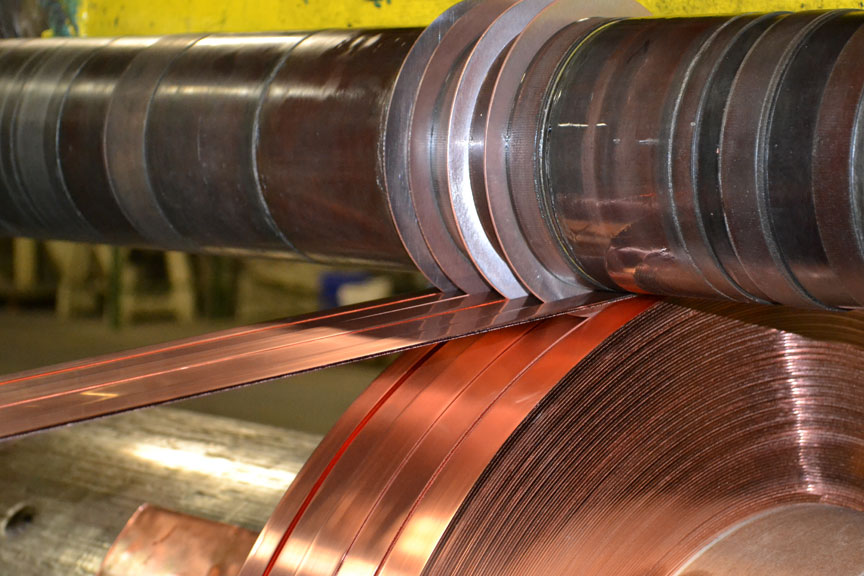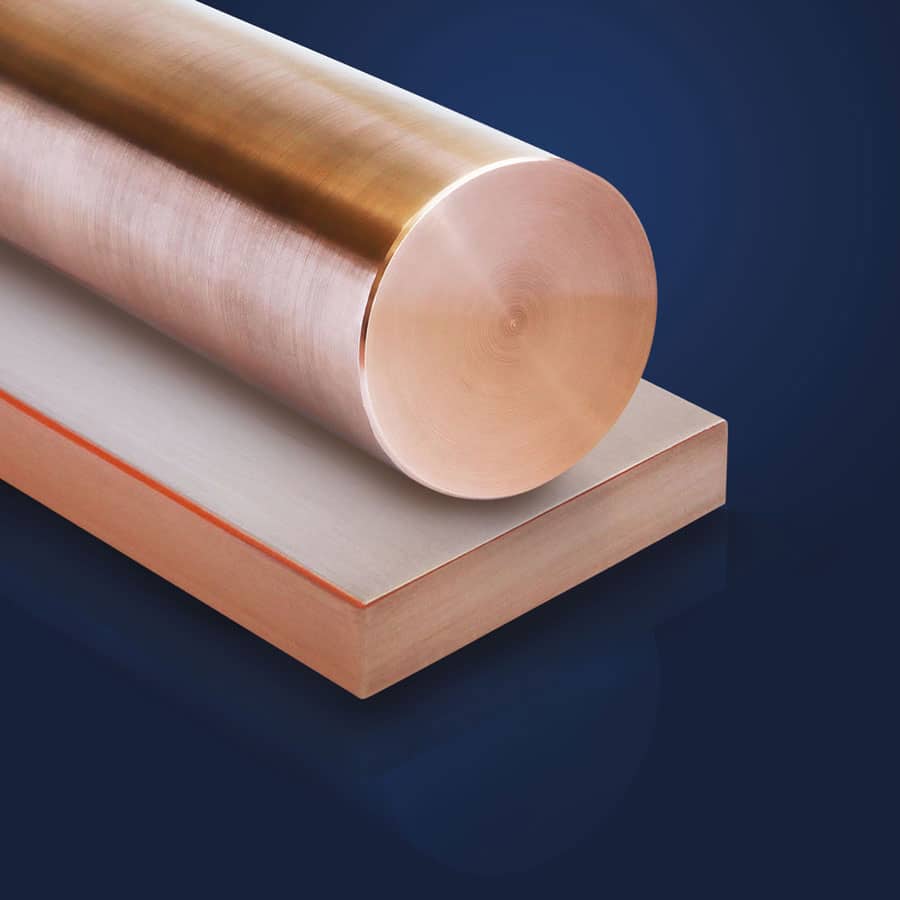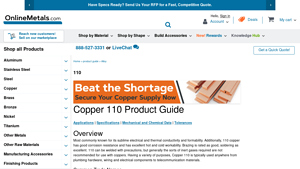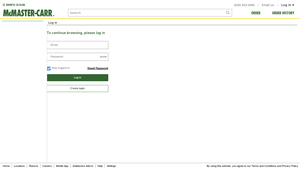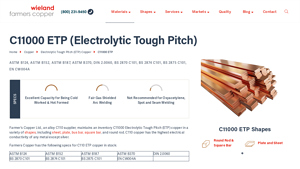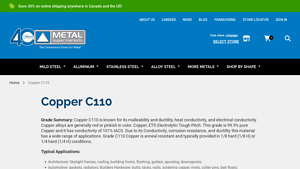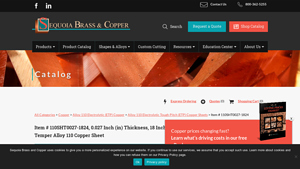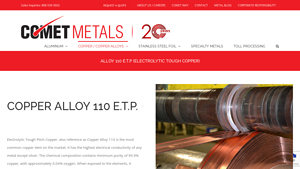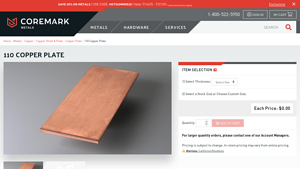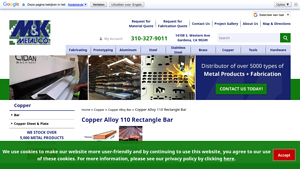Copper Alloy 110 Guide: Type, Cost, Top List…
Introduction: Navigating the Global Market for copper alloy 110
Navigating the complexities of sourcing copper alloy 110 can be a daunting task for international B2B buyers, particularly given the alloy’s significance in various industries, from electrical engineering to construction. This guide is designed to address the key challenges faced by businesses in acquiring this versatile material. With its exceptional electrical and thermal conductivity, along with high corrosion resistance, copper alloy 110—often referred to as C110 or Electrolytic Tough Pitch copper—stands out as an optimal choice for applications ranging from wiring and plumbing to decorative hardware.
In this comprehensive resource, we delve into the various types of copper alloy 110, explore its diverse applications, and provide insights into effective supplier vetting processes. Additionally, we offer a detailed analysis of cost considerations, ensuring that buyers from Africa, South America, the Middle East, and Europe, including markets like Germany and Saudi Arabia, can make informed purchasing decisions.
By empowering buyers with essential knowledge and actionable insights, this guide aims to simplify the sourcing process, helping businesses to secure high-quality copper alloy 110 that meets their specific needs. Whether you are a seasoned buyer or new to the market, understanding these critical factors will enhance your procurement strategy and drive operational success.
Understanding copper alloy 110 Types and Variations
| Type Name | Key Distinguishing Features | Primary B2B Applications | Brief Pros & Cons for Buyers |
|---|---|---|---|
| C11000 (ETP Copper) | 99.9% copper content, excellent electrical conductivity | Electrical components, wiring, plumbing | Pros: High conductivity, corrosion resistance. Cons: Limited mechanical strength compared to alloys. |
| C11000-H02 | Half-hard temper, improved strength | Electrical bus bars, connectors | Pros: Better strength than soft variants. Cons: Less ductility for complex shapes. |
| C11000-H04 | Full hard temper, high tensile strength | Heavy-duty electrical applications | Pros: Enhanced strength, suitable for high-load applications. Cons: Reduced formability, higher machining difficulty. |
| C11000-H00 | Soft, fully annealed, maximum ductility | Decorative hardware, architectural elements | Pros: Excellent formability, ideal for intricate designs. Cons: Lower strength, not suitable for load-bearing applications. |
| C11000 (Foil) | Thin gauge, lightweight, flexible | Electronics, thermal management | Pros: Great for heat dissipation, easy to work with. Cons: Fragile, not suitable for structural applications. |
What are the characteristics and suitability of C11000 (ETP Copper) for B2B buyers?
C11000, also known as Electrolytic Tough Pitch (ETP) copper, is characterized by its 99.9% copper purity, making it a top choice for applications demanding high electrical and thermal conductivity. It is widely used in electrical components, wiring, and plumbing due to its excellent corrosion resistance. B2B buyers should consider C11000 for projects requiring reliable conductivity and durability, particularly in environments with moisture or corrosive elements. Its limitations in mechanical strength may necessitate the use of additional support structures in some applications.
How does the C11000-H02 variation enhance performance for electrical applications?
The C11000-H02 variant offers a half-hard temper, providing improved strength while maintaining good ductility. This makes it suitable for applications such as electrical bus bars and connectors, where a balance of strength and flexibility is essential. B2B buyers should prioritize this variation when seeking components that require enhanced performance under mechanical stress, without sacrificing the ease of installation and handling. However, its reduced ductility compared to softer grades may limit its use in complex shapes.
Why is C11000-H04 favored for heavy-duty applications?
C11000-H04 is a full hard temper variant that exhibits high tensile strength, making it ideal for heavy-duty electrical applications. This version is particularly advantageous for components that must withstand significant loads, such as heavy machinery and high-capacity electrical systems. Buyers in industries requiring robust and reliable materials should consider C11000-H04 for its superior strength. However, its lower formability can pose challenges during fabrication, necessitating careful planning in the design phase.
What advantages does C11000-H00 offer for decorative and architectural uses?
C11000-H00, with its fully annealed state, provides maximum ductility, making it perfect for decorative hardware and architectural elements. Its soft nature allows for intricate designs and easy manipulation, appealing to designers and architects. B2B buyers should leverage this variant for projects requiring aesthetic appeal and flexibility. However, its lower strength may not be suitable for structural applications where load-bearing capabilities are critical.
In what scenarios is C11000 (Foil) most effectively utilized?
C11000 foil is known for its thin gauge and lightweight properties, making it highly flexible and ideal for applications in electronics and thermal management. Its excellent heat dissipation capabilities make it a preferred choice in high-performance electronic devices. B2B buyers should consider C11000 foil for projects where thermal conductivity is paramount. However, the fragility of this form limits its use in structural applications, requiring careful handling during installation and use.
Key Industrial Applications of copper alloy 110
| Industry/Sector | Specific Application of copper alloy 110 | Value/Benefit for the Business | Key Sourcing Considerations for this Application |
|---|---|---|---|
| Electrical & Electronics | Wiring and electrical components | High conductivity ensures efficient energy transfer, reducing energy costs. | Ensure purity (99.9% copper) to avoid performance issues; consider suppliers with quality certifications. |
| Construction & Plumbing | Plumbing hardware (pipes and fittings) | Corrosion resistance enhances durability, reducing maintenance costs. | Verify compliance with local regulations and standards, especially for lead-free requirements. |
| Telecommunications | Connectors and cable components | Superior conductivity ensures reliable signal transmission, essential for high-speed communications. | Assess the availability of various shapes and sizes to meet specific project needs. |
| HVAC Systems | Heat exchangers and cooling systems | Excellent thermal conductivity improves efficiency and reduces operational costs. | Source from suppliers who offer custom solutions to fit specific HVAC designs. |
| Decorative Applications | Architectural features (e.g., facades, sculptures) | Aesthetic appeal combined with durability enhances property value. | Consider suppliers with design capabilities to create custom decorative elements. |
How is Copper Alloy 110 Utilized in Electrical and Electronics Applications?
Copper alloy 110 is a preferred choice for wiring and electrical components due to its exceptional electrical conductivity, which is critical for efficient energy transfer. Industries rely on C110 for manufacturing components like bus bars, connectors, and circuit boards. This alloy’s high purity (99.9% copper) minimizes resistance, thereby reducing energy losses and operational costs. Buyers in regions like Europe and the Middle East should ensure their suppliers can provide certification of material purity and compliance with international electrical standards.
What Role Does Copper Alloy 110 Play in Construction and Plumbing?
In the construction sector, copper alloy 110 is extensively used for plumbing hardware, including pipes and fittings. Its inherent corrosion resistance makes it ideal for both indoor and outdoor applications, significantly extending the lifespan of plumbing installations. This is particularly beneficial in regions with harsh environmental conditions, such as parts of Africa and South America. Buyers must verify that their suppliers adhere to local regulations regarding lead content and other safety standards to ensure compliance and quality.
How Does Copper Alloy 110 Benefit Telecommunications?
Telecommunications rely heavily on copper alloy 110 for connectors and cable components. The alloy’s superior conductivity ensures reliable signal transmission, which is essential for maintaining high-speed communications. This is particularly important in rapidly developing regions where infrastructure upgrades are common. International buyers should consider the availability of different shapes and sizes of C110 products to meet their specific project requirements and ensure they are sourced from reputable suppliers with a history of quality.
In What Ways is Copper Alloy 110 Used in HVAC Systems?
HVAC systems benefit from copper alloy 110 due to its excellent thermal conductivity, which enhances the efficiency of heat exchangers and cooling systems. By utilizing C110, businesses can achieve better energy efficiency, leading to lower operational costs. This is particularly relevant in hot climates found in the Middle East and parts of Africa. Buyers should seek suppliers who can provide custom solutions tailored to specific HVAC designs to maximize performance and efficiency.
What Advantages Does Copper Alloy 110 Offer for Decorative Applications?
Copper alloy 110 is increasingly used in decorative applications, such as architectural features and sculptures, due to its aesthetic appeal and durability. The alloy’s reddish hue adds a unique visual element to buildings and installations, enhancing property value. Buyers in Europe and South America should consider suppliers that offer design capabilities to create custom elements that meet their specific aesthetic and functional needs.
3 Common User Pain Points for ‘copper alloy 110’ & Their Solutions
Scenario 1: Sourcing Quality Copper Alloy 110 for High-Performance Applications
The Problem: B2B buyers often face challenges in sourcing high-quality copper alloy 110 that meets specific performance standards. In industries such as electronics and telecommunications, where electrical conductivity and reliability are paramount, sourcing subpar materials can lead to product failures, increased costs, and reputational damage. Buyers may struggle with suppliers who cannot guarantee the purity and characteristics of their copper alloy, leading to uncertainty in product performance and compliance with industry standards.
The Solution: To ensure the procurement of quality copper alloy 110, buyers should establish relationships with reputable suppliers who provide comprehensive material certifications. Request documentation that includes ASTM standards, such as ASTM B187 for copper alloys, to verify the material’s specifications. Additionally, conducting supplier audits can help assess their manufacturing processes and quality assurance protocols. When placing orders, specify the required properties, such as electrical conductivity (100% IACS for copper alloy 110) and corrosion resistance, to align with your application needs. Consider leveraging online platforms that connect you with multiple suppliers, allowing for competitive quotes and product comparisons while ensuring compliance with international standards.
Scenario 2: Ensuring Compatibility of Copper Alloy 110 in Diverse Applications
The Problem: Many buyers are unsure about the compatibility of copper alloy 110 with other metals in their applications, especially in mixed-metal assemblies. This uncertainty can lead to galvanic corrosion, reduced performance, or even equipment failures in environments where different metals interact. For instance, using copper alloy 110 with aluminum components without proper consideration can result in accelerated corrosion and structural integrity issues.
The Solution: To mitigate compatibility concerns, buyers should educate themselves on the electrochemical series and the principles of galvanic corrosion. When designing assemblies, consider using insulating materials or coatings between dissimilar metals to prevent direct contact. For mixed-metal applications, always consult the supplier for recommendations on compatible materials and protective measures. Additionally, conduct thorough testing of the assembled components under expected environmental conditions to ensure long-term performance. Engaging with a metallurgical consultant can also provide insights into optimal material choices for specific applications, enhancing overall reliability.
Scenario 3: Overcoming Fabrication Challenges with Copper Alloy 110
The Problem: Buyers often encounter difficulties in fabricating copper alloy 110 due to its unique properties. While it is highly formable, challenges such as achieving precise cuts or bends without compromising structural integrity can arise. Additionally, the welding process requires specific precautions to prevent issues like hydrogen embrittlement, which can lead to failures in critical applications.
The Solution: To address fabrication challenges, buyers should invest in training for their fabrication teams to understand the best practices for working with copper alloy 110. This includes using appropriate tools and techniques for cutting, bending, and welding. When welding, ensure the use of proper shielding gases and techniques to minimize the risk of embrittlement. For complex shapes or precision components, consider collaborating with specialized fabricators who have experience with copper alloys. Additionally, employing CAD software can streamline design processes and enhance accuracy in fabrication. Regularly revisiting and updating fabrication procedures based on feedback and performance outcomes can further improve efficiency and product quality.
Strategic Material Selection Guide for copper alloy 110
What Are the Key Properties of Copper Alloy 110?
Copper alloy 110, also known as Electrolytic Tough Pitch (ETP) copper, is renowned for its exceptional electrical and thermal conductivity, making it an ideal choice for various applications. With a chemical composition of 99.9% copper and minimal oxygen content, it possesses excellent ductility and malleability. These properties allow for easy fabrication, whether through bending, forming, or machining. Additionally, C110 exhibits good corrosion resistance, which is crucial for components exposed to varying environmental conditions. Its melting point ranges from 1,949°F to 1,981°F, ensuring stability under high-temperature applications.
What Are the Pros and Cons of Using Copper Alloy 110?
When evaluating copper alloy 110, several advantages stand out. Its high electrical and thermal conductivity ensures efficient performance in electrical components, while its formability allows for versatile applications across industries such as plumbing, telecommunications, and decorative hardware. Moreover, the alloy’s corrosion resistance contributes to its longevity, reducing maintenance costs over time.
However, there are limitations to consider. While C110 can be welded, the process requires precautions due to the potential for hydrogen embrittlement. Additionally, the cost of pure copper can be higher than other materials, which may affect budget constraints for some projects. The complexity of manufacturing processes, especially for intricate designs, may also pose challenges.
How Does Copper Alloy 110 Impact Specific Applications?
Copper alloy 110 is particularly suitable for applications that require excellent conductivity and corrosion resistance. In electrical wiring and components, its high conductivity ensures minimal energy loss, making it a preferred choice for energy-efficient systems. In plumbing, its ductility allows for easy installation and adaptability to various configurations. However, buyers must consider the specific media compatibility, especially in plumbing applications, where exposure to certain chemicals can affect performance.
What Should International B2B Buyers Consider When Selecting Copper Alloy 110?
International buyers, especially from regions like Africa, South America, the Middle East, and Europe, should be aware of compliance with local standards such as ASTM, DIN, and JIS. Understanding these standards is critical for ensuring product quality and safety. Additionally, factors such as lead content regulations, especially in plumbing applications, should be taken into account. Buyers should also consider the availability of suppliers who can meet their specific requirements regarding size, form, and quantity, as well as the logistical aspects of shipping and delivery.
Summary Table of Copper Alloy 110 Material Analysis
| Material | Typical Use Case for copper alloy 110 | Key Advantage | Key Disadvantage/Limitation | Relative Cost (Low/Med/High) |
|---|---|---|---|---|
| Copper Alloy 110 | Electrical wiring, plumbing hardware | Superior electrical and thermal conductivity | Requires careful welding precautions | Medium |
| Copper Alloy 110 | Telecommunications equipment | Excellent ductility and formability | Higher cost compared to other alloys | Medium |
| Copper Alloy 110 | Decorative architectural elements | Good corrosion resistance | Complexity in manufacturing intricate designs | Medium |
| Copper Alloy 110 | Industrial electrical components | Long-lasting performance | Limited compatibility with certain chemicals | Medium |
This analysis provides a comprehensive overview of copper alloy 110, highlighting its properties, advantages, and considerations for international B2B buyers. Understanding these factors can facilitate informed decision-making when selecting materials for various applications.
In-depth Look: Manufacturing Processes and Quality Assurance for copper alloy 110
What Are the Key Stages in the Manufacturing Process of Copper Alloy 110?
The manufacturing process of copper alloy 110, also known as C110 or Electrolytic Tough Pitch (ETP) copper, is a meticulous operation that involves several critical stages: material preparation, forming, assembly, and finishing.
Material Preparation
The initial phase in the manufacturing of C110 involves sourcing high-purity copper, with a minimum of 99.9% copper content. This purity is crucial for ensuring optimal electrical and thermal conductivity. Suppliers often conduct rigorous checks on the raw materials to ensure they meet specified chemical compositions, which is essential for maintaining the integrity of the alloy. This may include testing for impurities such as oxygen, which should not exceed 0.04%.
Forming Techniques
Once the materials are prepared, the next step is forming. Various techniques are employed depending on the desired end product, including extrusion, rolling, and forging.
- Extrusion is commonly used to create long shapes like bars and rods, allowing for uniformity in cross-sectional areas.
- Rolling processes can produce sheets and plates, enhancing the material’s surface finish and thickness uniformity.
- Forging may be utilized for components requiring higher strength and durability.
Cold-working processes are also frequently applied to enhance the mechanical properties of the alloy, allowing for increased strength without compromising ductility. It’s important to note that while C110 can be welded, specific precautions must be taken, particularly regarding the type of inert gases used.
Assembly and Fabrication
In assembly, C110 components are often combined with other materials to create finished products. This stage may involve soldering, which is considered excellent for copper alloys due to their favorable thermal properties. Proper techniques must be employed to avoid oxidation during soldering, which can negatively impact electrical connectivity.
Additionally, the assembly process may include the integration of C110 with other metals or plastics in applications like electrical connectors or plumbing fixtures, where versatility is key.
Finishing Processes
The finishing stage is vital for ensuring that the final product meets aesthetic and functional requirements. Techniques such as plating, anodizing, or polishing can be applied to enhance the surface quality and corrosion resistance. This stage also includes rigorous cleaning processes to remove any manufacturing residues that could affect performance.
What Quality Assurance Measures Are Commonly Implemented in C110 Production?
Quality assurance (QA) is a critical aspect of the manufacturing process for copper alloy 110. This ensures that the final products not only meet international standards but also satisfy the specific needs of B2B buyers.
Which International Standards Should Be Considered?
Manufacturers of C110 copper alloy typically adhere to international quality standards such as ISO 9001, which outlines requirements for a quality management system. Compliance with these standards signifies that a manufacturer has implemented effective processes for continuous improvement and customer satisfaction.
In addition to ISO standards, industry-specific certifications may also be relevant, such as CE marking for products sold within the European Economic Area and API (American Petroleum Institute) specifications for products used in the oil and gas industry.
What Are the Key Quality Control Checkpoints?
Quality control during the manufacturing of C110 typically involves several critical checkpoints:
- Incoming Quality Control (IQC): This involves the initial inspection of raw materials to ensure they meet specified chemical and physical properties before production begins.
- In-Process Quality Control (IPQC): Throughout the manufacturing process, samples are taken at various stages to monitor compliance with production specifications. This may include dimensional checks and material tests.
- Final Quality Control (FQC): Once production is complete, a thorough inspection is conducted to verify that the finished products meet all specifications and standards. This may include mechanical testing, electrical conductivity tests, and surface finish assessments.
How Can B2B Buyers Verify Supplier Quality Control?
For B2B buyers, especially those from regions such as Africa, South America, the Middle East, and Europe, it’s crucial to ensure that suppliers maintain high-quality standards. Here are some strategies for verification:
- Audits: Conducting regular audits of suppliers can provide insights into their manufacturing processes and quality assurance practices. This may include reviewing documentation related to their quality management systems and process controls.
- Quality Reports: Requesting detailed quality reports and certificates of compliance for products can help buyers assess whether the manufacturer meets required standards. This should include test results for mechanical properties and conductivity.
- Third-Party Inspections: Engaging third-party inspection services can provide an unbiased assessment of a supplier’s quality control processes. These firms can conduct on-site inspections and testing, ensuring that products meet international standards before shipment.
What Are the Specific Quality Control Considerations for International B2B Buyers?
International buyers should be aware of nuances in quality control that may differ from local practices. For example, understanding regional standards, such as those specific to the European Union or GCC countries, is essential for compliance and market acceptance.
Moreover, communication with suppliers regarding quality expectations is crucial. Establishing clear specifications and performance metrics upfront can help avoid misunderstandings and ensure that the delivered products meet the necessary criteria.
Conclusion
The manufacturing and quality assurance processes for copper alloy 110 are intricate and require a comprehensive approach to ensure high-quality outputs. By understanding these processes, B2B buyers can make informed decisions when sourcing C110 products, ensuring they align with international standards and meet specific application needs. Engaging with suppliers who prioritize quality control and adhere to relevant certifications will ultimately enhance product reliability and performance in various applications.
Practical Sourcing Guide: A Step-by-Step Checklist for ‘copper alloy 110’
This guide serves as a practical checklist for B2B buyers looking to procure copper alloy 110 (C110). Copper alloy 110 is renowned for its excellent electrical and thermal conductivity, malleability, and corrosion resistance, making it a vital material in various industries. Following these steps will help you make informed purchasing decisions and ensure that you acquire high-quality products.
Step 1: Define Your Technical Specifications
Before initiating the procurement process, clearly outline your technical requirements for copper alloy 110. Consider factors such as the desired form (bars, sheets, or custom shapes), temper (e.g., H02 for half-hard), and specific mechanical properties like tensile strength and hardness. This clarity will guide your supplier selection and ensure that the material meets your application needs.
Step 2: Research Reliable Suppliers
Conduct thorough research to identify reputable suppliers specializing in copper alloy 110. Look for companies with a strong track record in the industry and positive customer reviews. Supplier credibility is essential, as it impacts product quality and reliability in fulfilling orders.
Step 3: Evaluate Potential Suppliers
Before committing, it’s crucial to vet suppliers thoroughly. Request company profiles, case studies, and references from buyers in a similar industry or region. Focus on their experience with copper alloys, specifically C110, and inquire about their production capabilities and quality assurance processes.
Step 4: Verify Certifications and Compliance
Ensure that your chosen suppliers hold relevant industry certifications and comply with international standards. Certifications such as ISO 9001 indicate a commitment to quality management, while adherence to ASTM specifications for copper alloys is crucial for performance. Compliance with local regulations, especially regarding lead content in plumbing applications, is also essential.
Step 5: Request Samples for Evaluation
Before making a large order, request samples of copper alloy 110 to evaluate the quality. Assess the material for its conductivity, formability, and finish. Testing samples will provide insight into how well the alloy meets your specifications and expectations.
Step 6: Compare Pricing and Terms
Once you have shortlisted potential suppliers, compare pricing structures and payment terms. While cost is a significant factor, consider the overall value, including shipping costs, lead times, and after-sales support. A slightly higher price may be justified by superior quality or better service.
Step 7: Establish a Communication Protocol
Maintain clear communication with your chosen supplier throughout the procurement process. Set expectations regarding timelines, order modifications, and delivery schedules. Effective communication helps mitigate misunderstandings and ensures a smoother transaction, ultimately leading to a successful partnership.
Following this step-by-step checklist will streamline your sourcing process for copper alloy 110, ensuring that you secure the best material for your business needs while fostering strong supplier relationships.
Comprehensive Cost and Pricing Analysis for copper alloy 110 Sourcing
What Are the Key Cost Components for Sourcing Copper Alloy 110?
When sourcing copper alloy 110, understanding the cost structure is crucial for B2B buyers. The main cost components include materials, labor, manufacturing overhead, tooling, quality control (QC), logistics, and margin.
-
Materials: Copper alloy 110, known for its high electrical and thermal conductivity, primarily consists of 99.9% pure copper. The price of copper fluctuates based on market conditions, impacting overall sourcing costs.
-
Labor: Labor costs can vary significantly based on the region of production. Skilled labor is often required for the processing and handling of copper alloys, which can increase costs in regions with higher wage standards.
-
Manufacturing Overhead: This includes expenses related to facilities, utilities, and equipment maintenance. Overhead costs can vary widely depending on the supplier’s operational efficiency and location.
-
Tooling: The initial investment in tooling for specific production runs can affect pricing. Customized tooling for unique specifications often incurs higher costs but can lead to better quality and reduced waste.
-
Quality Control: Ensuring that copper alloy 110 meets specific standards requires robust QC measures. This can involve testing for conductivity, mechanical properties, and certification, which adds to the overall cost.
-
Logistics: Shipping and handling costs can significantly impact pricing, especially for international buyers. Factors such as distance, transportation mode, and customs duties play a role in logistics expenses.
-
Margin: Suppliers will factor in a profit margin based on their operational costs and market demand. Understanding the margin helps buyers gauge the competitiveness of the pricing.
How Do Price Influencers Impact Copper Alloy 110 Costs?
Several factors can influence the price of copper alloy 110 beyond the basic cost components:
-
Volume/MOQ: Larger orders typically lead to lower per-unit costs due to economies of scale. Suppliers may offer discounts for minimum order quantities (MOQ), making it beneficial for buyers to consolidate their purchases.
-
Specifications/Customization: Custom specifications can increase costs due to the need for specialized production processes. Buyers should clarify their requirements to avoid unexpected charges.
-
Material Quality/Certifications: Higher quality materials or specific certifications (such as ISO standards) can elevate costs. However, investing in quality can reduce long-term operational issues.
-
Supplier Factors: The supplier’s reputation, location, and production capabilities can affect pricing. Established suppliers with a track record of reliability may command higher prices, but they often provide better service and quality assurance.
-
Incoterms: Understanding Incoterms is essential for international transactions. They define the responsibilities of buyers and sellers regarding shipping, insurance, and tariffs, which can impact the total landed cost.
What Negotiation Strategies Can B2B Buyers Use for Cost-Efficiency?
For international B2B buyers, particularly in regions like Africa, South America, the Middle East, and Europe, effective negotiation strategies are key to achieving cost-efficiency:
-
Research Market Prices: Before negotiating, conduct thorough market research to understand current pricing trends for copper alloy 110. This enables informed discussions and strengthens your position.
-
Leverage Volume Discounts: If possible, consolidate orders across different projects to meet MOQs. This approach can lead to significant savings through bulk purchasing.
-
Ask for Transparency: Request a breakdown of costs from suppliers. Understanding how each component contributes to the total price can help identify areas for negotiation.
-
Evaluate Total Cost of Ownership: Consider not just the initial purchase price but the total cost of ownership, including maintenance, potential downtime, and replacement costs. A slightly higher upfront cost may be justified by long-term savings.
-
Be Flexible with Specifications: If your project allows for some flexibility in specifications, discuss alternative options that may lower costs without compromising quality.
What Should International Buyers Keep in Mind?
For buyers in Africa, South America, the Middle East, and Europe, it’s essential to navigate pricing nuances effectively. Currency fluctuations, import tariffs, and local regulations can impact pricing and should be factored into the budget. Additionally, establishing long-term relationships with reliable suppliers can lead to better pricing and service over time.
Disclaimer: Prices for copper alloy 110 are indicative and can vary widely based on market conditions, supplier agreements, and order specifics. Always consult multiple suppliers for the most accurate pricing.
Alternatives Analysis: Comparing copper alloy 110 With Other Solutions
Understanding Alternatives to Copper Alloy 110
When evaluating materials for industrial applications, it’s essential to consider alternatives that may better meet specific performance, cost, and operational requirements. Copper Alloy 110, known for its exceptional electrical and thermal conductivity, is a popular choice in various sectors, including electrical, plumbing, and telecommunications. However, other materials may offer comparable or enhanced features depending on the intended application. Below, we explore two viable alternatives to Copper Alloy 110: Aluminum Alloy 6061 and Brass Alloy C360.
Comparison Table
| Comparison Aspect | Copper Alloy 110 | Aluminum Alloy 6061 | Brass Alloy C360 |
|---|---|---|---|
| Performance | Excellent electrical and thermal conductivity; good corrosion resistance | Good strength-to-weight ratio; moderate conductivity | High machinability; good corrosion resistance; fair conductivity |
| Cost | Moderate | Generally lower | Higher than aluminum |
| Ease of Implementation | Requires specialized welding techniques; good formability | Easier to fabricate and weld; versatile | Easily machinable; good for intricate designs |
| Maintenance | Low maintenance due to corrosion resistance | Moderate; may require protective coatings | Moderate; can corrode if not maintained |
| Best Use Case | Electrical components, plumbing, decorative applications | Structural components, automotive, aerospace | Precision machining, plumbing fittings, musical instruments |
Detailed Breakdown of Alternatives
Aluminum Alloy 6061
Aluminum Alloy 6061 is a versatile material known for its lightweight and good mechanical properties. Its strength-to-weight ratio makes it an excellent choice for structural applications, particularly in the automotive and aerospace industries. While its electrical conductivity is lower than that of Copper Alloy 110, it compensates with ease of fabrication and welding. However, it may require protective coatings to prevent corrosion in specific environments, which can add to maintenance costs.
Brass Alloy C360
Brass Alloy C360 is renowned for its exceptional machinability and is often used in precision parts and fittings. While it offers good corrosion resistance, its electrical conductivity is not as high as that of Copper Alloy 110. C360 is ideal for applications requiring intricate designs, such as musical instruments and decorative hardware. However, the cost of brass can be higher than that of aluminum, making it less attractive for large-scale applications where budget constraints are a priority.
Conclusion: Making the Right Choice for Your Application
Choosing the right material for your project hinges on understanding the specific requirements of your application. Copper Alloy 110 excels in electrical and thermal conductivity, making it a prime choice for electrical components and plumbing. However, if weight savings and ease of fabrication are paramount, Aluminum Alloy 6061 may be the better option. For projects requiring intricate designs and high machinability, Brass Alloy C360 could be the preferred choice. Assessing performance, cost, and maintenance needs will guide B2B buyers in selecting the most suitable material for their industrial applications, ensuring both efficiency and cost-effectiveness.
Essential Technical Properties and Trade Terminology for copper alloy 110
What Are the Key Technical Properties of Copper Alloy 110?
Copper Alloy 110, also known as Electrolytic Tough Pitch (ETP) copper, is recognized for its superior electrical and thermal conductivity, making it essential in various industrial applications. Here are some critical specifications that B2B buyers should be aware of:
-
Material Grade: Copper Alloy 110 is composed of 99.9% copper and 0.1% oxygen. This high purity level contributes to its excellent conductivity and ductility, making it ideal for applications in electrical wiring and components. Understanding the material grade helps buyers ensure compatibility with specific applications, particularly in industries requiring high-performance materials.
-
Tensile Strength: The ultimate tensile strength of C110 can range from 32,000 psi in the annealed state to 50,000 psi in the hard-tempered state. This measure indicates the maximum stress the material can withstand while being stretched before failing. For manufacturers, selecting the appropriate tensile strength is crucial for ensuring the integrity and durability of products, especially in demanding environments.
-
Electrical Conductivity: C110 boasts an electrical conductivity rating of 100% IACS (International Annealed Copper Standard). This exceptional conductivity makes it highly suitable for electrical applications, such as bus bars and electromagnets. Buyers should prioritize this property when sourcing materials for electrical systems, as it directly impacts efficiency and performance.
-
Thermal Conductivity: With a thermal conductivity rating of 2,690 BTU-in/hr-ft²-°F, Copper Alloy 110 is also an excellent heat conductor. This property is vital for applications involving heat exchangers, cooking equipment, and other thermal systems. Understanding thermal conductivity helps B2B buyers evaluate the material’s suitability for their specific needs.
-
Corrosion Resistance: C110 exhibits good corrosion resistance, particularly in non-aggressive environments. This characteristic extends the lifespan of components exposed to moisture and other environmental factors. Buyers should consider this property when selecting materials for outdoor applications or environments prone to corrosion.
-
Machinability: The machinability of Copper Alloy 110 is rated at approximately 20%, making it relatively easy to work with during fabrication processes. This is a significant factor for manufacturers looking to reduce production costs and enhance efficiency. Understanding machinability ensures that buyers can select the right materials that align with their manufacturing capabilities.
What Are Common Trade Terms Relevant to Copper Alloy 110?
Understanding the jargon associated with Copper Alloy 110 is crucial for effective communication and negotiation in the B2B environment. Here are some commonly used terms:
-
OEM (Original Equipment Manufacturer): This term refers to companies that produce parts or equipment that may be marketed by another manufacturer. In the context of Copper Alloy 110, OEMs often require high-quality materials for creating electrical components and other products. Knowing this term helps buyers identify potential suppliers who cater to their specific needs.
-
MOQ (Minimum Order Quantity): MOQ denotes the minimum number of units a supplier is willing to sell. Understanding MOQ is essential for buyers to avoid over-committing to a purchase while ensuring they meet the supplier’s requirements. This can be particularly important for international buyers dealing with logistics and storage.
-
RFQ (Request for Quotation): An RFQ is a document sent to suppliers to request pricing and terms for specific products, including Copper Alloy 110. This process is vital for buyers looking to compare offers from different suppliers and negotiate better deals.
-
Incoterms (International Commercial Terms): These are standardized trade terms that define the responsibilities of buyers and sellers regarding shipping, insurance, and tariffs. Familiarity with Incoterms helps buyers understand their obligations in international transactions, facilitating smoother negotiations and logistics.
-
Lead Time: This refers to the time between placing an order and receiving the product. Understanding lead times is critical for planning and inventory management, particularly for businesses that rely on timely delivery of materials like Copper Alloy 110.
-
Certifications: These are documents that verify the quality and composition of the materials supplied. Certifications are crucial for B2B buyers to ensure compliance with industry standards and regulations, especially when sourcing Copper Alloy 110 for specialized applications.
By grasping both the technical properties and the essential trade terminology associated with Copper Alloy 110, B2B buyers can make informed decisions that align with their operational needs and market demands.
Navigating Market Dynamics and Sourcing Trends in the copper alloy 110 Sector
What Are the Key Trends Influencing the Copper Alloy 110 Market?
The copper alloy 110 sector is witnessing significant growth driven by its exceptional electrical and thermal conductivity, making it indispensable in various industries, including electronics, telecommunications, and construction. Global trends indicate an increasing demand for energy-efficient solutions and renewable energy technologies, where C110 copper plays a pivotal role. The rise of electric vehicles and renewable energy systems is propelling the demand for C110 in applications such as charging stations, electric motors, and energy storage solutions.
Additionally, the ongoing digital transformation across industries is reshaping sourcing practices. B2B buyers are increasingly leveraging digital platforms for procurement, enabling them to access a wider range of suppliers and streamline their sourcing processes. This shift towards e-commerce and online marketplaces enhances competition and transparency, allowing buyers to obtain competitive pricing and better-quality materials.
Moreover, geopolitical factors, such as trade policies and tariffs, are impacting sourcing strategies. Buyers from Africa, South America, the Middle East, and Europe must remain agile, adapting to changes in supply chain dynamics and exploring alternative sourcing options to mitigate risks associated with global disruptions.
How Can B2B Buyers Ensure Sustainability and Ethical Sourcing for Copper Alloy 110?
Sustainability is a critical consideration in the procurement of copper alloy 110, given the environmental impacts associated with mining and processing copper. B2B buyers are increasingly prioritizing suppliers who demonstrate commitment to sustainable practices, such as responsible mining and reduced carbon footprints. Ethical sourcing involves ensuring that materials are obtained through fair labor practices and with minimal environmental degradation.
To align with sustainability goals, buyers should look for suppliers that offer certifications for recycled content or eco-friendly processes. Materials with ‘green’ certifications, such as the International Organization for Standardization (ISO) certifications, can provide assurance of a supplier’s commitment to environmental stewardship.
Additionally, engaging with suppliers who embrace circular economy principles—recycling and reusing materials—can further enhance sustainability efforts. B2B buyers can also consider the full lifecycle of copper alloy products, opting for those that offer longevity and recyclability, thereby reducing waste and environmental impact.
What Is the Historical Context of Copper Alloy 110 in B2B Markets?
Copper alloy 110, also known as Electrolytic Tough Pitch (ETP) copper, has a rich history rooted in its unique properties and versatility. First recognized in the early 20th century, its formulation as 99.9% pure copper with minimal oxygen content allowed for superior electrical conductivity, setting a standard for electrical applications.
Over the decades, the demand for C110 has expanded from traditional uses in wiring and plumbing to modern applications in high-tech industries, including telecommunications and renewable energy. This evolution is marked by continuous advancements in manufacturing processes and an increased focus on sustainability, reflecting the changing needs of global markets.
As B2B buyers navigate the current landscape, understanding the historical significance of copper alloy 110 can provide insights into its reliability and performance, ensuring informed sourcing decisions that meet both technical requirements and ethical standards.
Frequently Asked Questions (FAQs) for B2B Buyers of copper alloy 110
-
How do I determine the right specifications for copper alloy 110?
To choose the right specifications for copper alloy 110, assess your project’s requirements, including electrical and thermal conductivity, mechanical properties, and corrosion resistance. C110, with a copper content of 99.9%, offers excellent electrical conductivity (100% IACS) and thermal conductivity, making it ideal for electrical components. Review the mechanical properties such as tensile strength and hardness based on your application. Consulting with suppliers for material data sheets and expert recommendations can further ensure that you select the appropriate grade for your needs. -
What applications are best suited for copper alloy 110?
Copper alloy 110 is widely used in applications requiring high electrical and thermal conductivity. Common uses include wiring, electrical components, plumbing hardware, and telecommunications. Its excellent formability allows for easy shaping into various components, including bus bars and electromagnets. Additionally, C110 is suitable for decorative hardware due to its appealing color. Understanding your specific application will help you leverage the alloy’s properties effectively. -
What factors should I consider when vetting suppliers of copper alloy 110?
When vetting suppliers, consider their industry experience, product quality, and compliance with international standards. Request certifications (such as ISO 9001) to ensure adherence to quality management practices. Examine their inventory to confirm they can meet your specifications and lead times. Additionally, assess their logistics capabilities, especially if you’re sourcing from different continents, to ensure timely delivery. Customer reviews and testimonials can also provide insights into their reliability and service quality. -
What is the minimum order quantity (MOQ) for copper alloy 110?
The minimum order quantity (MOQ) for copper alloy 110 can vary significantly between suppliers, often ranging from a few kilograms to several tons. It is essential to communicate your specific needs and inquire about the MOQ during the sourcing process. Some suppliers may offer flexibility for smaller orders, especially for new customers or projects. Understanding the MOQ will help you plan your procurement strategy and budget effectively. -
What payment terms are typically offered for international orders of copper alloy 110?
Payment terms for international orders can vary widely, but common practices include net 30, net 60, or letters of credit. Suppliers might require a deposit upfront, especially for large orders, with the balance due upon shipment or delivery. It is essential to negotiate terms that align with your cash flow and project timelines. Ensure that you have a clear understanding of currency exchange rates and any additional fees that may apply to international transactions. -
How can I ensure quality assurance when sourcing copper alloy 110?
To ensure quality assurance, request material certification and test reports from your supplier, detailing compliance with industry standards like ASTM B187. Consider suppliers who employ rigorous quality control processes, including regular inspections and third-party testing. Additionally, visiting the supplier’s facility or utilizing a trusted inspection service can provide further assurance of product quality. Establishing a clear communication channel for addressing quality concerns will also help maintain standards throughout the procurement process. -
What are the logistics considerations when importing copper alloy 110?
Logistics considerations for importing copper alloy 110 include shipping methods, customs regulations, and delivery timelines. Evaluate whether air or sea freight is more suitable based on urgency and cost. Familiarize yourself with the customs duties and regulations in your country to avoid unexpected delays. Collaborating with a freight forwarder experienced in handling metal imports can streamline the process and ensure compliance with all international shipping requirements. -
Can copper alloy 110 be customized for specific applications?
Yes, copper alloy 110 can be customized based on the specific needs of your application. Suppliers often offer various shapes and forms, including sheets, bars, and custom dimensions. You can also request specific tempers or mechanical properties tailored to your project requirements. When discussing customization with suppliers, provide detailed specifications and any unique requirements to facilitate accurate production and minimize lead times.
Important Disclaimer & Terms of Use
⚠️ Important Disclaimer
The information provided in this guide, including content regarding manufacturers, technical specifications, and market analysis, is for informational and educational purposes only. It does not constitute professional procurement advice, financial advice, or legal advice.
While we have made every effort to ensure the accuracy and timeliness of the information, we are not responsible for any errors, omissions, or outdated information. Market conditions, company details, and technical standards are subject to change.
B2B buyers must conduct their own independent and thorough due diligence before making any purchasing decisions. This includes contacting suppliers directly, verifying certifications, requesting samples, and seeking professional consultation. The risk of relying on any information in this guide is borne solely by the reader.
Top 8 Copper Alloy 110 Manufacturers & Suppliers List
1. Online Metals – Copper 110
Domain: onlinemetals.com
Registered: 1997 (28 years)
Introduction: Copper 110 is known for its excellent electrical and thermal conductivity, formability, and good corrosion resistance. It has excellent hot and cold workability, with good brazing and excellent soldering capabilities. Welding is possible with precautions. Common applications include plumbing hardware, wiring, electrical components, and telecommunications. Trade names include UNS C11000, CDA 110 ET…
2. McMaster – Copper Alloy 110 Products
Domain: mcmaster.com
Registered: 1994 (31 years)
Introduction: This company, McMaster – Copper Alloy 110 Products, is a notable entity in the market. For specific product details, it is recommended to visit their website directly.
3. Farmers Copper – C11000 ETP Copper
Domain: farmerscopper.com
Registered: 1998 (27 years)
Introduction: C11000 ETP (Electrolytic Tough Pitch) Copper – Alloy C110 Supplier | Farmers Copper, LTD. Specifications: ASTM B124, ASTM B152, ASTM B187, ASTM B370, DIN 2.0060, BS 2870 C101, BS 2874 C101, BS 2875 C101, EN CW004A. Features: Excellent capacity for being cold worked & hot formed; Fair gas shielded arc welding; Not recommended for oxyacetylene, spot, and seam welding. Available shapes: Round Rod (1/…
4. Metal Supermarkets – Copper C110
Domain: metalsupermarkets.com
Registered: 1996 (29 years)
Introduction: This company, Metal Supermarkets – Copper C110, is a notable entity in the market. For specific product details, it is recommended to visit their website directly.
5. Sequoia Brass & Copper – Alloy 110 Electrolytic Tough Pitch Copper Sheet
Domain: catalog.sequoia-brass-copper.com
Registered: 1998 (27 years)
Introduction: {“Item Number”:”110SHT0027-1824″,”Thickness”:”0.027 Inch”,”Width”:”18 Inch”,”Length”:”24 Inch”,”Temper”:”H00″,”Alloy Type”:”Alloy 110 Electrolytic Tough Pitch Copper Sheet”,”Weight”:”3.7558 lb”,”Finish”:”Mill”,”Standard”:”ASTM B370″,”UNS Number”:”C11000″,”Trade Names”:”ETP, Electrolytic Tough Pitch Copper”,”List Price”:”$98.48″}
6. Comet Metals – Alloy 110 E.T.P (Electrolytic Tough Copper)
Domain: cometmetals.com
Registered: 2003 (22 years)
Introduction: {“Alloy Name”: “Alloy 110 E.T.P (Electrolytic Tough Copper)”, “Purity”: “99.9% copper (min.)”, “Oxygen Content”: “0.04% (approx.)”, “Corrosion Resistance”: “Excellent to good in most environments, not suitable for acetylene, ammonia, chromic acid, nitric acid, mercury or mercury salts.”, “Forms Available”: [“sheet”, “strip”, “plate”, “wire”, “rod”, “bar”, “tube”, “extruded shapes”], “Applications”…
7. Coremark Metals – 110 Copper Plate
Domain: coremarkmetals.com
Registered: 2018 (7 years)
Introduction: {“product_name”: “110 Copper Plate”, “description”: “110 Copper plate is an excellent candidate for some processing techniques as well as both indoor and outdoor applications. Commonly referred to as Electrolytic Tough Pitch Copper (ETP), copper alloy 110 has great corrosion resistance and conducts electricity. The material is non-magnetic with a semi-smooth surface and defined edges. Copper plate…
8. M&K Metal Co. – Copper Alloy 110 Rectangle Bar
Domain: mkmetal.net
Registered: 1999 (26 years)
Introduction: Copper Alloy 110 Rectangle Bar from M&K Metal Co. Located at 14108 S. Western Ave, Gardena, CA 90249. Contact via phone at 310-327-9011. The company offers over 5,000 types of metal products including fabrication services. The product falls under the category of Copper Alloy Bar.
Strategic Sourcing Conclusion and Outlook for copper alloy 110
How Can Strategic Sourcing Enhance Your Procurement of Copper Alloy 110?
In summary, copper alloy 110 (C110) stands out for its exceptional electrical and thermal conductivity, corrosion resistance, and excellent formability. For international B2B buyers, especially in regions like Africa, South America, the Middle East, and Europe, leveraging strategic sourcing can significantly enhance procurement efficiency and cost-effectiveness. By aligning with reputable suppliers, businesses can ensure access to high-quality materials that meet industry standards, ultimately leading to improved product performance and customer satisfaction.
The value of strategic sourcing lies not only in cost savings but also in fostering long-term supplier relationships that can provide insights into market trends and innovations. As demand for reliable and versatile materials continues to grow, particularly in sectors such as electronics, plumbing, and telecommunications, the need for a proactive sourcing strategy becomes even more critical.
Looking ahead, international buyers should seize the opportunity to engage with trusted suppliers and explore the diverse applications of copper alloy 110. By doing so, they can position their businesses advantageously in an increasingly competitive landscape. Take action now to secure your supply chain and enhance your product offerings with copper alloy 110, ensuring you remain at the forefront of your industry.
